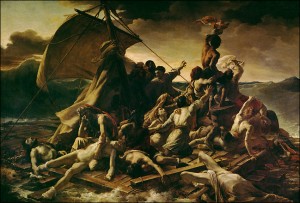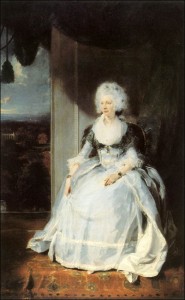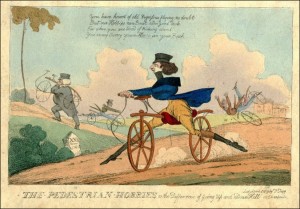All links are to Wikipedia entries.
Government, Politics, and War:
- Prime minister Lord Liverpool bolsters Britain’s monetary system by restoring the gold standard.
- February 6: Singapore comes under British occupation under Sir Stamford Raffles.
- April – June: Select Committee of the House of Commons inquires into the state of disease and condition of the poor in Ireland as the typhus epidemic continues.
- August 16: At what becomes known as the Peterloo Massacre. eleven are killed and over 500 injured when the cavalry charges into a large public meeting in St. Peter’s Fields in Manchester, which had been organized to protest the Corn Laws and agitate for radical political reform.
- August: Radical reformer Henry Hunt, who was supposed to address the St. Peter’s Fields meeting but never got the chance, is charged along with others with holding an “unlawful and seditious assembling for the purpose of exciting discontent,” found guilty, and is sentenced to 2½ years’ imprisonment.
- October: Richard Carlile, another speaker at the St. Peter’s Fields meeting who had begun publishing a radical newspaper, The Republican, shortly after the Peterloo Massacre, is found guilty of blasphemy and seditious libel and sentenced to 3 years imprisonment. He will continue publishing The Republican from prison.
- December 30: In the wake of the Peterloo Massacre, Parliament passes the Six Acts to prevent further disturbances. They are: the Training Prevention Act (or Unlawful Drilling Act), the Seizure of Arms Act, the Misdemeanors Act, the Seditious Meetings Prevention Act, the Blasphemous and Seditious Libels Act (or Criminal Libel Act), and the Newspaper and Stamp Duties Act.
Society and Social History:
- William Bullock sells all the contents of his famous museum by auction.
- The world’s first eating chocolate to be produced commercially goes on sale in Switzerland: François-Louis Cailler introduces the first chocolate to be prepared and sold in blocks made by machine. (Until this time, chocolate had primarily been used for beverages.)
- March 20: The Burlington Arcade opens in London.
- May: Princess Victoria (later to reign as Queen Victoria) is born to the Duke and Duchess of Kent.
 Literature, Journalism, and Publishing:
Literature, Journalism, and Publishing:
- Walter Scott’s Ivanhoe is published.
- William Wordsworth begins another major revision of The Prelude.
- German philosopher Arthur Schopenhauer publishes The World as Will and Representation in which he builds upon Kant’s metaphysical system of transcendental idealism and than rejects it in favor his own philosophy of the human will as the essence of experience.
- In England, Richard Carlile is convicted of blasphemy and sent to prison for publishing The Age of Reason by Thomas Paine.
- John William Polidori publishes The Vampyre.
- Washington Irving begins publishing The Sketch Book of Geoffrey Crayon in seven installments—the first of which includes “Rip Van Winkle” and the last of which includes “The Legend of Sleepy Hollow”—simultaneously in the United States and England.
- Percy Bysshe Shelley writes the political sonnet England in 1819.
- April 21: John Keats writes La Belle Dame sans Merci.
- May – June: Keats produces many of his most famous odes, including Ode to Psyche, Ode on a Grecian Urn, Ode to a Nightingale, Ode on Melancholy, and To Autumn.
- July: Lord Byron publishes, anonymously, the first two Cantos of Don Juan.
- August: Percy Bysshe Shelley writes The Mask of Anarchy in reaction to the Peterloo Massacre and sent it to a newspaper for publication, although the poem was not published until 1832.

Raft of the Medusa by Théodore Géricault. (Click on image to see a larger version and to read more about it.)
Art, Architecture, and Design:
- The Prado Museum (Museo del Prado) opens in Madrid.
- John Constable paints The White Horse and is elected an Associate of the Royal Academy (though he was not elected to full membership until 1829).
- Francisco Goya begins the series of “Black Paintings”, working directly onto the walls of his dining and sitting rooms at his home, Quinta del Sordo, near Madrid.
- Théodore Géricault’s Raft of the Medusa is exhibited at the Paris Salon.
- J. M. W. Turner paints Childe Harold’s Pilgrimage.
- May 2: Painter Mary Moser dies. She was one of only two female founders of the Royal Academy. (Angelica Kauffman was the other.)
- August: Thomas Telford begins construction of the Menai Suspension Bridge between the Welsh mainland and the island of Anglesey..
Music:
- Gioacchino Rossini composes the operas Bianca e Falliero, La donna del lago, Eduardo e Cristina, and Ermione.
- Soprano Giuditta Pasta makes her stage début in Venice.
Science and Industry:
- Cambridge Philosophical Society is founded as a scientific society at the University of Cambridge.
- June 20: The first steamship to cross the Atlantic arrives in Liverpool.
- August 25: James Watt, Scottish inventor and mechanical engineer, dies at age 83. His improvements to the steam engine were fundamental to the changes brought by the Industrial Revolution.
Natural History and Exploration:
- In India, the Ajanta Caves are rediscovered by a British hunting party. The 4th-2nd century BCE paintings and sculptures are considered masterpieces of Buddhist religious art.
- British explorer John Franklin undertakes a new expedition to locate the Northwest Passage on behalf of the Admiralty. The Arctic expedition is poorly prepared, its boats are too heavy to be portaged and too small to hold all the necessary supplies, and the sailors know nothing about survival techniques. Most died of starvation, but there was also at least one murder and suggestions of cannibalism. Franklin is one of the few to survive, and he is lionized at home as “the man who ate his boots.”
- A British Arctic expedition under William Edward Parry comprising HMS Hecla and HMS Griper reaches longitude 112°51′ W in the Northwest Passage, the farthest west which will be attained by any single-season voyage for 150 years.
- February 19: Captain William Smith in British merchant brig Williams discovers the South Shetland Islands.



